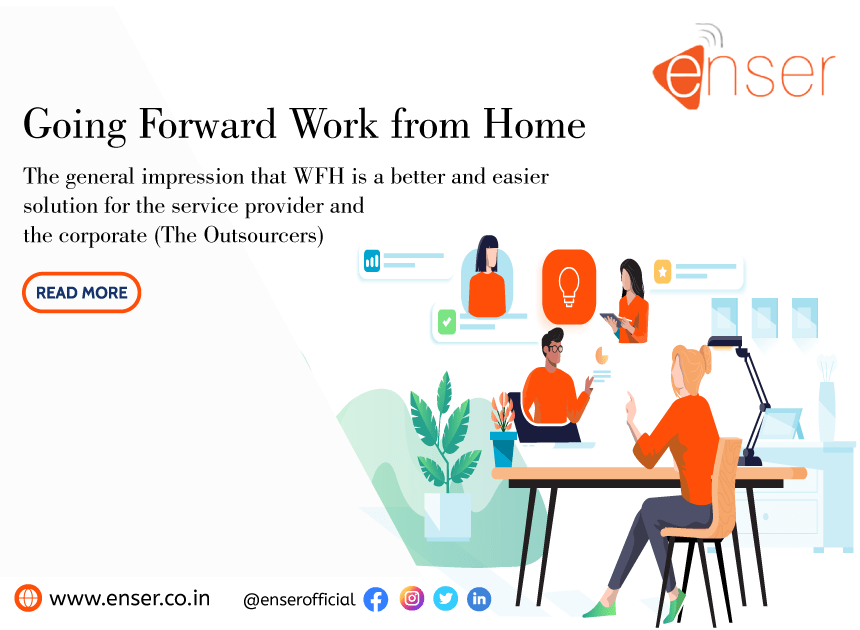The general impression that WFH is a better and easier solution for the service provider and the corporate (The Outsourcer)
Though over a period of time Work From Home( WFH) concept may turn out to be good, currently it is a myth since there is an increase in costs from WFH coming up for various reasons as well as the logistics of managing a widespread team.
Team Management
It is very challenging to manage a widespread and huge team remotely. Team management is the most difficult aspect of the WFH scenario.
Cyber Security Threats
This is going to be the single most important challenge for companies across the board, with information and databases floating all over, this is a real challenge, also to be able to put this to rest, the service providers are going to be incurring the additional cost of tools and software at desktop level to enterprise level plus consultants are being utilized to handle this real challenge. This is increasing costs too.
Increased IT Costs
The workload of IT professionals is increasing, especially BPO/Contact Center as they have to manage the process by managing the desktops of agents sitting remotely. Thus it increases the overall IT expenditure of the company.
Increased Incremental costs
Since the pandemic and WFH has picked up, over a period of time the expectation of employees, even though now working remotely, will demand an increment in salaries, as the requirement of employees with WFH scenario is increasing, and making it easier for employees to move over.
Doubling of Resources
Every employer has all infrastructures at the office and has now to organize the same for the employees to work from home too. This will add to the expenditure for the same including logistics of moving desktops, laptops, monitors, etc. to employee location. Needless to mention the additional costs of the equipment, transportations, loss of inventory if not returned, if an employee goes missing or leaves the company and doesn’t pay for or return the inventory.
Apart from this, most service providers who have implemented WFH, have been carrying additional inventories of PC’s, headsets, which if one liquidates is additional cost or loss in the capex of hardware, say for example if the PC (even if depreciated value) is around 15000/- post the pandemic’s one year time period is down to say a value of 6000 or so, so the Rs. 9000 per PC is the loss that the Service provider is incurring if he retains or even sells off the equipment, expecting it to be lying unutilised for still some period of time.
Lowered Service Quality Due to Bad Infrastructure
Generally, employees do not have quality infrastructure at their location. All employees may not have the most conducive environments at home to be able to serve the customers, this could add to lower sales volumes or bad quality of client interactions. Obviously, the infrastructure being used at the employee’s end will also bring about bad voice quality recordings, especially in case of contact center interactions, where it may be mandatory to store such customer interaction recordings for the requirements of the regulator. Imagine someone that operates from a 1 room tenement, where in a family of 4 or 5 are staying together, how does one manage to be able to offer the environment of a top of the line, environment and infrastructure of an IT park with dedicated work area, conference, training facility etc. This will surely cause a dent in the customer experience.
Increased Telecom Costs
There will be an increase in the telecom costs to monitor the employees and talk to them multiple times a day. For example what could happen at a single location can split into maybe 20-50 interactions for each supervisor, instead of just a single one in a centralized location while assessing their results and activities for the day?
Also the service provider needs to provide additional cost of telecom and internet to the agents apart from handsets when they are operating from home, this is additional cost.
Also, we need to know that the arrangement that the service providers have signed with Telecom service providers are additional and in most cases are still operational apart from the telecom cost now paid to the employees WFH. In fact, an additional increase of telecom is also affected because of plan for a disaster management site either from own location elsewhere or through a cloud service provider.
Work Culture at the Employee End
The culture at the employee end may also be a challenge especially for employees that don’t have the vision to represent the culture of the organization since nobody is watching them, casual and laid-back approach of operating from home especially for the lower-end jobs could be a challenge.
Infrastructure Management:
Since there is no clarity on the lockdown timings and durations, it is becoming extremely challenging to manage the infra, as lease rentals are frozen and are slightly difficult to change, as it involves contracts plus the large sum of money as deposit, etc. So 1 month you could need infra for 300 employees, for which you have allocated an infra, with IT, Telecom, etc. and the next month, you may need to move to say 200 people to get them to WFH, this is easy said than done, as seen by the writer specifically in real environment cases. Now imagine the plight of service provider, where he ends up paying for more than 100 seat infra and the client is pushing for a reduction in costs for obvious reasons, while the service provider may be at times stuck with a larger infrastructure and not fully utilized and also paying the lease rentals for the same. Most service providers are working on the same with landlords, but this takes a while if there is a water-tight agreement in place.
However, looking at how the business scenario is changing, the service providers may have no other option but to move to such a scenario, or get ready for a hybrid model going forward. Both WFH and WFO have their inherent advantages, and a healthy blend should be maintained and customers should not get carried away in operating with just one scenario.
If there is a need with the current situation across the world, it now makes sense to plan for at least 50% of employees to operate from home, or to look at non-critical work to be WFH based soon, or even beyond the pandemic. There is a realization that corporate especially the MSME, need to plan for this going forward. The benefits for the same could be:
• Reduced cost of infra, and pass that to the customers, that are ever looking to reduce their costs in an ever-demanding environment from their Boards.
• Clarity to the service providers that they need to keep this quotient of WFH and WFO going forward.
• Increased tech tools to monitor as companies will have to look at designing tools for HRM, Monitoring, Workforce Management, Training, and Audio Video Conferencing, etc.
• Reduced admin costs like electricity, general admin, and office costs, etc. A reduced infra including generators and UPS could help meet the hybrid type of requirement.
Apart from this, the service providers will have to consistently work, to minimize the negative impacts of work from home and try and convert them into a USP going forward and maintain a healthy mix of WFH and WFO.
Rajnish Sarna
The writer is CMD of India’s leading BPO company Enser Communications Pvt. Ltd.





